engine CADILLAC DEVILLE 1996 7.G Owners Manual
[x] Cancel search | Manufacturer: CADILLAC, Model Year: 1996, Model line: DEVILLE, Model: CADILLAC DEVILLE 1996 7.GPages: 354, PDF Size: 20.32 MB
Page 251 of 354

Downloaded from www.Manualslib.com manuals search engine &‘
Removing the Wheel Cover
The tools you’ll be using include the jack (A) and the
wheel wrench
(B).
There is a center wheel cover on the aluminum wheel.
Using the flat end
of the wheel wrench, gently pry the
wheel cover off. Be careful not to scratch the aluminum
wheel edge and don’t
try to remove it with your hands.
Page 252 of 354
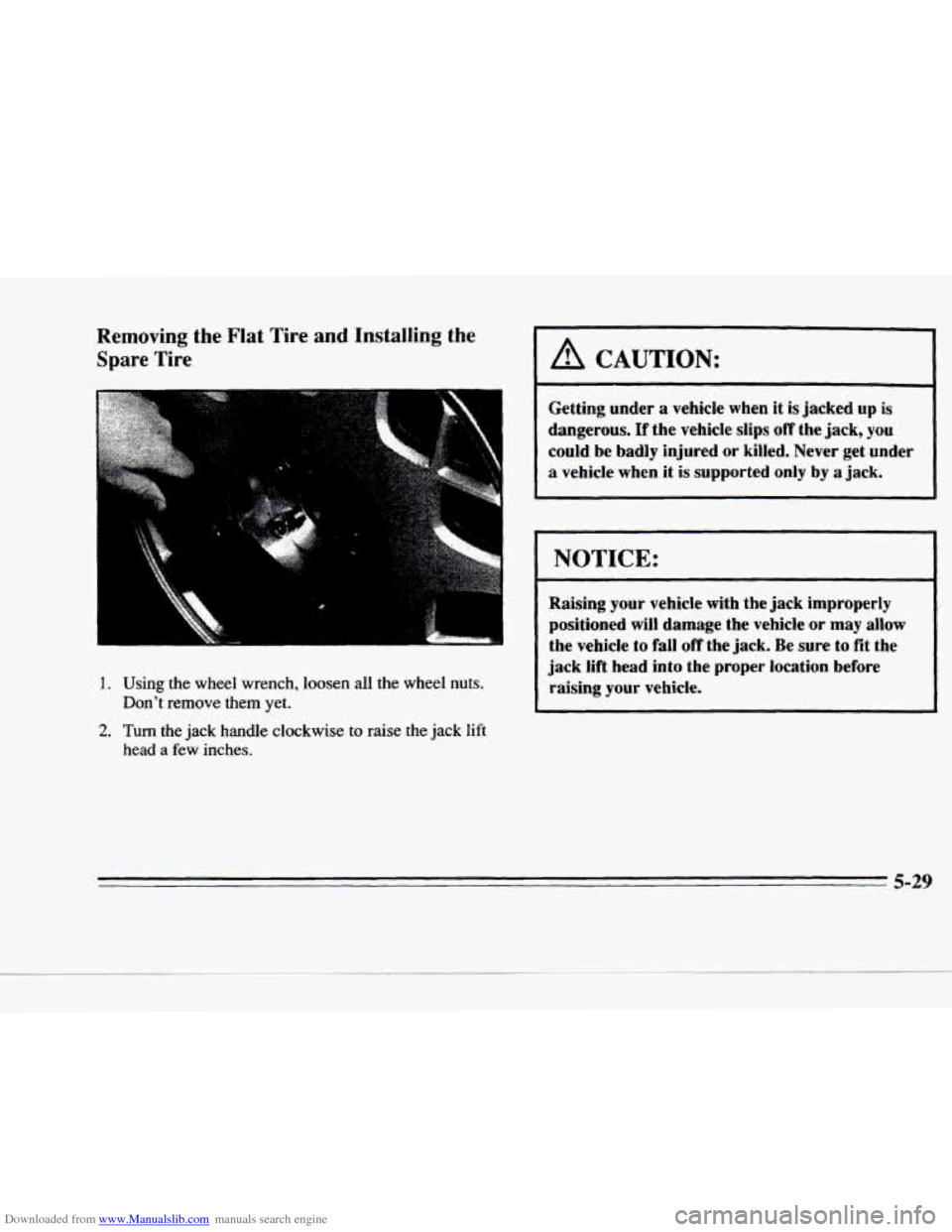
Downloaded from www.Manualslib.com manuals search engine Removing the Flat Tire and Installing the
Spare Tire
1. Using the wheel wrench, loosen all the wheel nuts.
Don’t remove them yet.
2. Turn the jack handle clockwise to raise the jack lift
head a few inches.
A CAUTION:
Getting under a vehicle when it is jacked up is
dangerous. If the vehicle slips off the jack, you
could be badly injured or killed. Never get under
a vehicle when it is supported only by a jack.
NOTICE:
Raising your vehicle with the jack improperly
positioned will damage the vehicle or may allow
the vehicle to
fall off the jack. Be sure to fit the
jack lift head into the proper location before
raising your vehicle.
5-29
Page 253 of 354
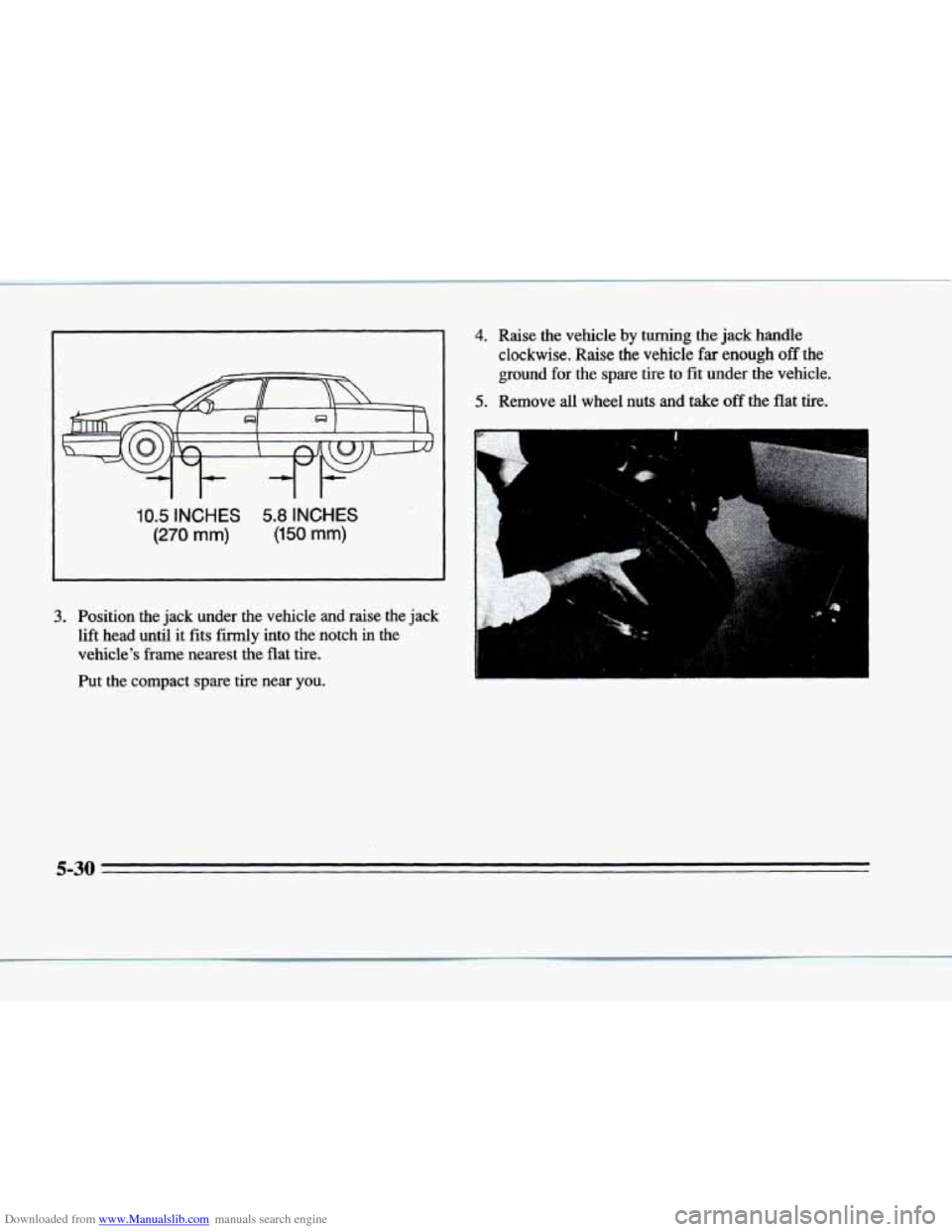
Downloaded from www.Manualslib.com manuals search engine 10.5 INCHES
(270 mm)
5.8 INCHES
(150 mm)
3. Position the jack under the vehicle and raise the jack lift head until it fits firmly into the notch
in the
vehicle's
frame nearest the flat tire.
Put the compact spare tire near
you.
4. Raise the vehicle by turning the jack handle
clockwise. Raise the vehicle
far enough off the
ground
for the spare tire to fit under the vehicle.
5. Remove all wheel nuts and take off the flat tire.
Page 254 of 354
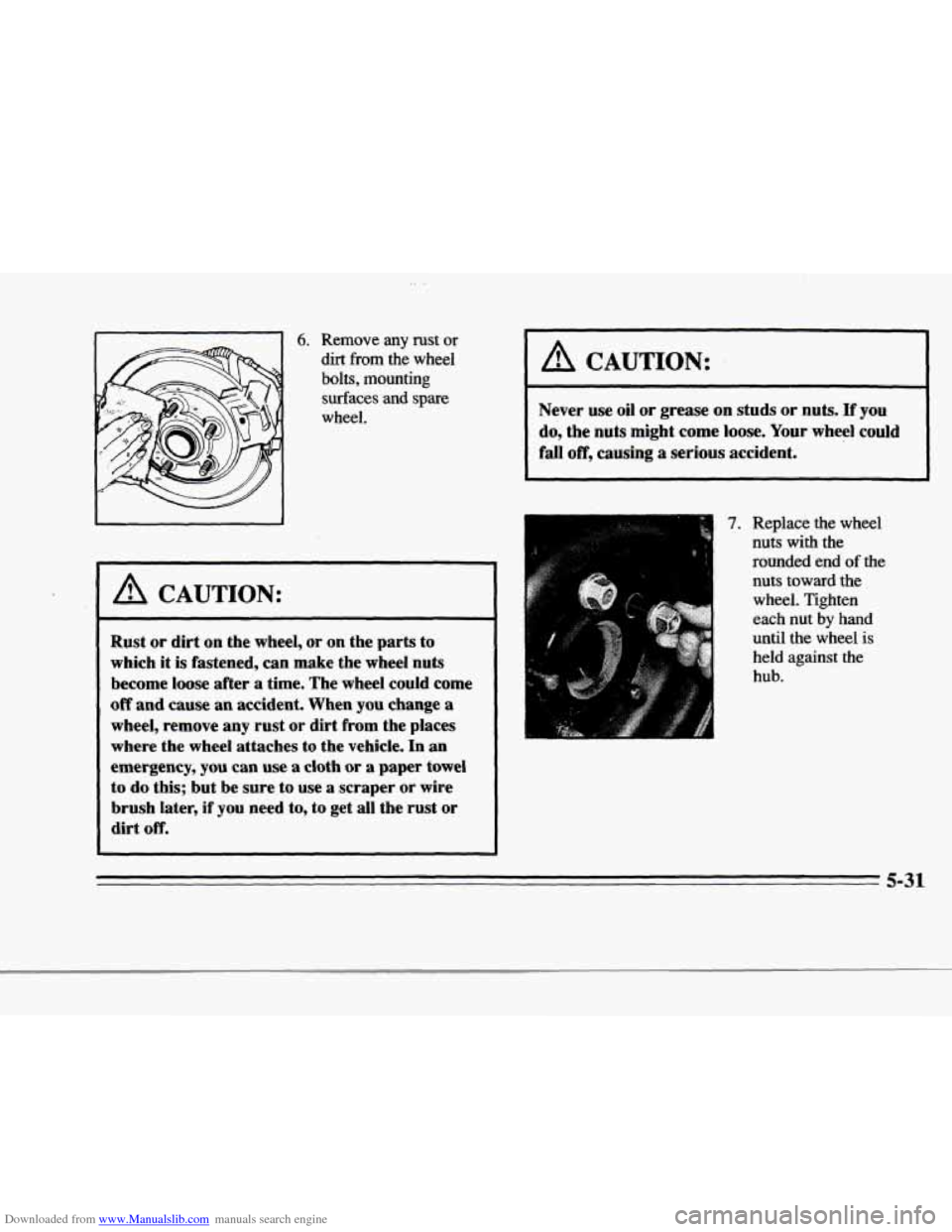
Downloaded from www.Manualslib.com manuals search engine r
r
P
t
r
r
dirt from the wheel
bolts, mounting surfaces
and spare
wheel.
A CAUTION:
Rust or dirt on the wheel, or on the parts to
which it is fastened, can make the wheel
nuts
become loose after a time. The wheel could come
off and cause an accident. When you change a
wheel, remove any rust or dirt from the places
where the wheel attaches to the vehicle.
In an
emergency, you can use a cloth or a paper towel
to do this; but be sure to use a scraper or wire
brush later, if you need to, to get all the rust or
dirt off.
I A CAUTION:
~ ~~
Never use oil or grease on studs or nuts. If you
do, the nuts might come loose. Your wheel could
fall off, causing a serious accident.
- 7. Replace the wheel
nuts with the
rounded end of the
nuts toward the wheel. Tighten
each nut
by hand
until the wheel
is
held against the
hub.
5-3 1
P I
Page 255 of 354

Downloaded from www.Manualslib.com manuals search engine 8. Lower the vehicle by turning the jack handle
counterclockwise. Lower the jack completely.
9. Tighten the
wheel nuts firmly
in a criss-cross
sequence
as shown.
A CAUTION:
Incorrect wheel nuts or improperly tightened
wheel nuts can cause the wheel
to become loose
and
even come off. This could lead to an accident.
Be
sure to use the correct wheel nuts. If you have
to replace them, be sure to get the right kind.
Stop somewhere
as soon as you can and have the
nuts tightened with a torque wrench to
100 lb-ft
(140 N-m).
5-32
Page 256 of 354
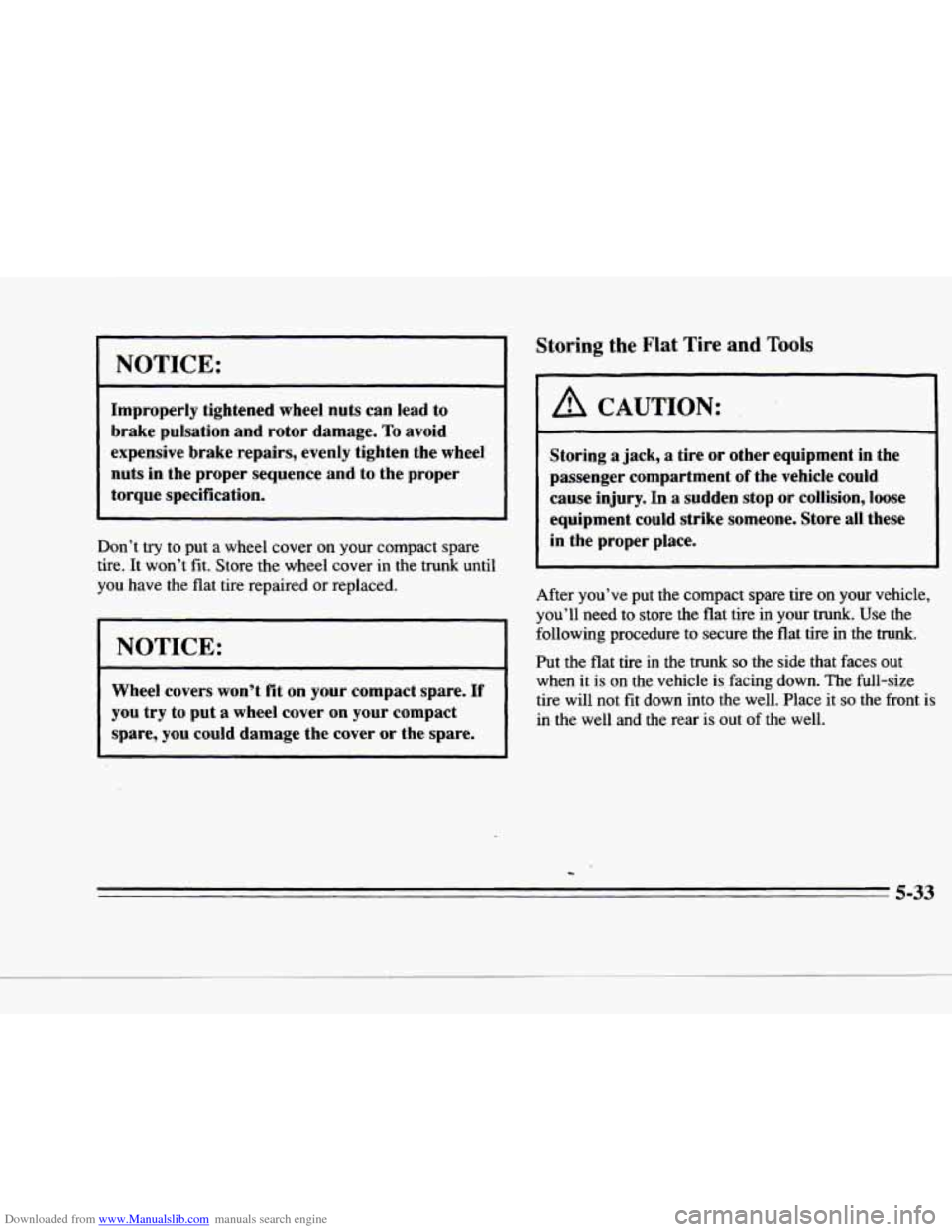
Downloaded from www.Manualslib.com manuals search engine c
c-
P
c
NOTICE:
Improperly tightened wheel nuts can lead to
brake pulsation and rotor damage.
To avoid
expensive brake repairs, evenly tighten the wheel
nuts in the proper sequence and to the proper
torque specification.
Don’t
try to put a wheel cover on your compact spare
tire. It won’t
fit. Store the wheel cover in the trunk until
you have the flat tire repaired or replaced.
NOTICE:
Wheel covers won’t fit on your compact spare. If
you try to put a wheel cover on your compact
spare,
you could damage the cover or the spare.
Storing the Flat Tire and Tools
. ..
A CAUTION:
Storing a jack, a tire or other equipment in the
passenger compartment of the vehicle could
cause injury. In
a sudden stop or collision, loose
equipment could strike someone. Store all these
in the proper place.
After you’ve put the compact spare tire on your vehicle,
you’ll need to store
the flat tire in your trunk. Use the
following procedure
to secure the flat tire in the trunk.
Put the
flat tire in the trunk so the side that faces out
when it is on the vehicle is facing down. The full-size
tire will not
fit down into the well. Place it so the front is
in the well and the rear is out of the well.
5-33
Page 257 of 354

Downloaded from www.Manualslib.com manuals search engine Secure the tire with the stud cap that was used to hold
the compact spare in place. Store the cover as far
forward as possible.
Storing the Spare Tire and Tools
I A CAUTION:
Storing a jack, a tire or other equipment in the
passenger compartment
of the vehicle could
cause injury. In
a sudden stop or collision, loose
equipment could strike someone. Store all these
in the proper place.
5-34
Page 258 of 354
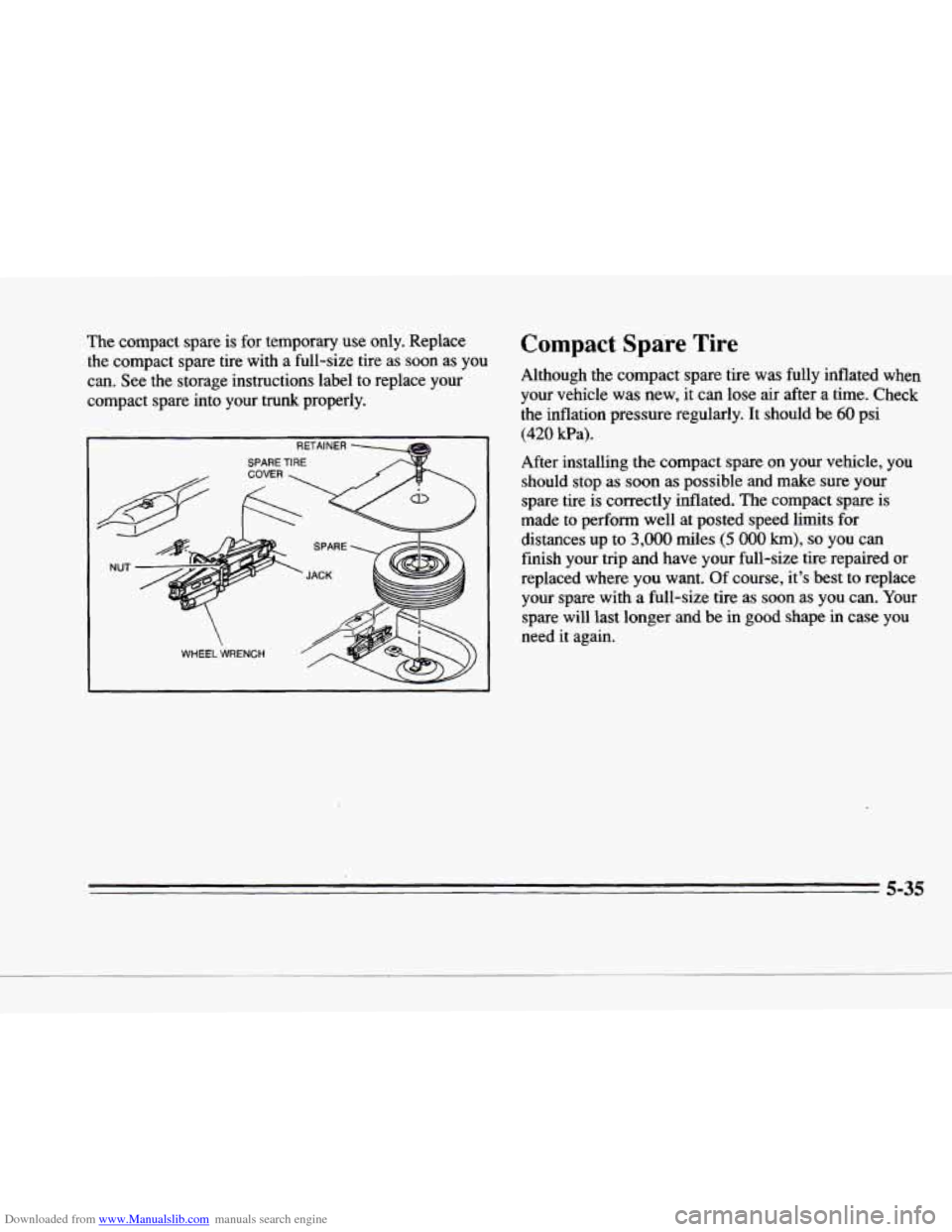
Downloaded from www.Manualslib.com manuals search engine .-
P
The compact spare is for temporary use only. Replace the compact spare tire with a full-size tire as
soon as you
can. See the storage instructions label to replace your
compact spare into your trunk properly.
Compact Spare Tire
Although the compact spare tire was fully inflated when
your vehtcle
was new, it can lose air after a time. Check
the inflation pressure regularly.
It should be 60 psi
(420 Wa).
After installing the compact spare on your vehicle, you
should stop
as soon as possible and make sure your
spare tire is correctly inflated. The compact spare is
made to perform well at posted speed limits for distances up to
3,000 miles (5 000 km), so you can
finish your trip and have your full-size tire repaired or
replaced where you want. Of course, it’s best to replace your spare with
a full-size tire as soon as you can. Your
spare will last longer and be in
good shape in case you
need it again.
5-35
Page 259 of 354
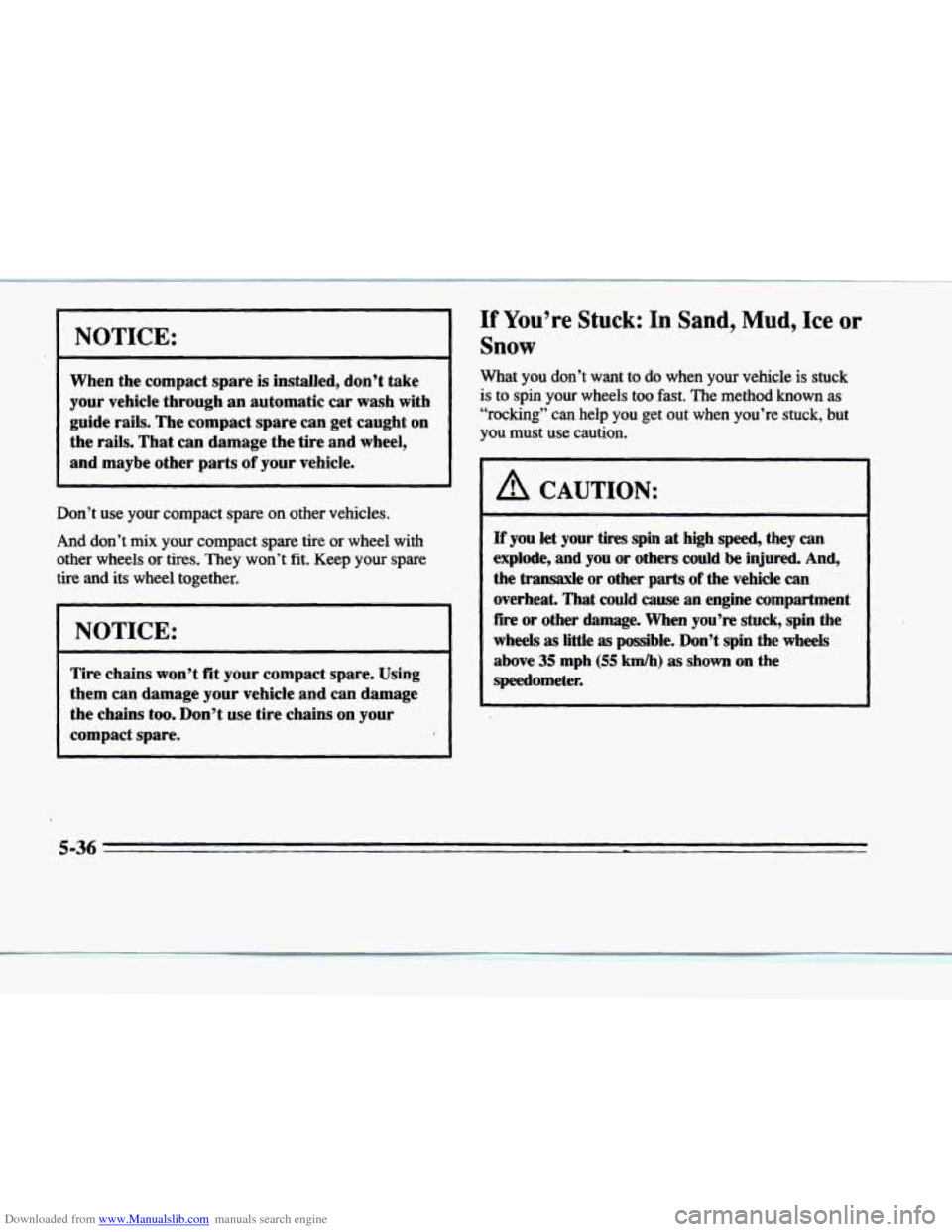
Downloaded from www.Manualslib.com manuals search engine ~~~ ~
~~ ~ NOTICE:
When
the compact spare is installed, don’t take
your vehicle through an automatic car wash with
guide rails. The compact spare can get caught on
the rails. That can damage the tire and wheel,
and maybe other parts
of your vehicle.
Don’t use your compact spare on other vehicles.
And don’t mix your compact spare tire or wheel with
other wheels
or tires. They won’t fit. Keep your spare
tire and its wheel together.
NOTICE:
Tire chains won’t fit your compact spare. Using
them can damage
your vehicle and can damage
the chains too. Don’t use tire chains on
your
compact spare.
~ ~~ ~~~ ~
~~
If You’re Stuck: In Sand, Mud, Ice or
Snow
What you don’t want to do when your vehicle is stuck
is to spin your wheels too fast. The method known as
“rocking” can help you get out when you’re stuck, but
you must use caution.
A CAUTION:
If you let your tires spin at high speed, they can
explode, and you or others could be injured. And,
the transaxle or other parts
of the vehicle can
overheat. That could
cause an engine compartment
fire or other damage. When
you’re stuck, spin the
wheels
as little as possible. Don’t spin the wheels
above
35 mph (55 kdh) as shown on the
speedometer.
5-36 &
I
1
I
Page 260 of 354
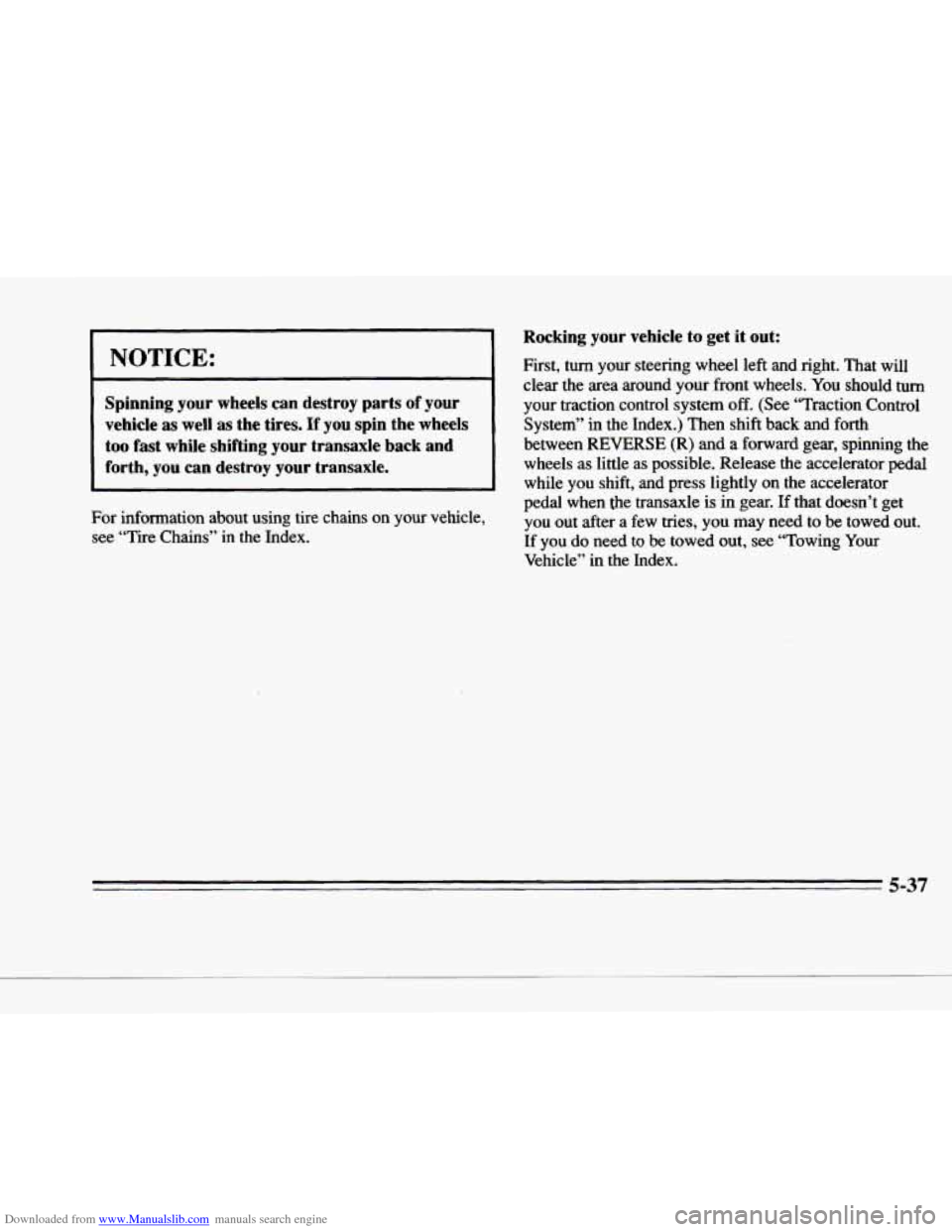
Downloaded from www.Manualslib.com manuals search engine P
I NOTICE:
Spinning your wheels can destroy parts of your
vehicle as well
as the tires. If you spin the wheels
too fast while shifting your transaxle back and
forth,
you can destroy your transaxle.
For information about using tire chains on your vehicle, see “Tire Chains” in the Index.
Rocking your vehicle to get it out:
First, turn your steering wheel left and right. That will
clear the
area around your front wheels. You should
1 your traction control system off. (See “Traction Control
1 System” in the Index.) Then shift back and forth
between
REVERSE (R) and a forward gear, spinning the
1 wheels as little as possible. Release the accelerator pedal
~ while you shift, and press lightly on the accelerator
pedal when fie transaxle
is in gear. If that doesn’t get
you out after a
few tries, you may need to be towed out.
If you do need to be towed out, see “Towing Your
Vehicle’’ in the Index.
5-37